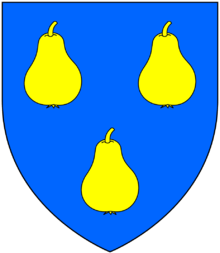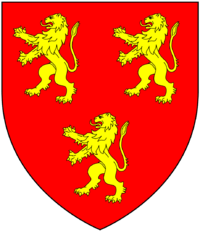Richard Stucley

Motto: Bellement et Hardiment ("beautifully and bravely")
Richard Stucley (d.1440/1) (alias Styuecle, etc.) of Trent in Somerset,[2] of Merston in Sussex[3][4] and of Chewton Mendip in Somerset, was thrice Member of Parliament for Sussex, in 1415, March 1416 and 1417.[5] He was the father of Hugh I Stucley, Sheriff of Devon in 1448, who married Catherine de Affeton, the heiress of Affeton in Devon, and founded the prominent Stucley family of Affeton. Via a female line he is the ancestor of the present Stucley baronets of Hartland Abbey and Affeton Castle in Devon.[6]
The Stucley family died out in the male line on the death, unmarried and without progeny, of Dennis Stucley (died 1755), Sheriff of Devon in 1748. The marriage of his aunt Sarah Stucley (died 1742), to George I Buck (1674–1743) of Bideford, brought Affeton to her grandson George II Buck (1731–1791), who became the heir on the death of Dennis Stucley in 1755. Buck's descendant George Stucley Buck (1812–1900) in 1858 assumed by royal licence the name and arms of Stucley and was created a baronet in 1859, becoming Sir George Stucley Buck Stucley, 1st Baronet.[7]
Origins
Little is known of his origins, but possibly he was a member of the important family of Stucley (alias Styuecle, Stukeley, etc.) which originated at the manor of Great Stukeley in Huntingdonshire.[8]
Marriage & progeny

At some time between 1396 and 1398 he married Elizabeth FitzRoger (1370-1414), the only child and sole heiress of John FitzRoger (died 1370/2) of Chewton in Somerset,[10] 3rd son of Sir Henry FitzRoger (died 1352) of Chewton by his wife Elizabeth de Holland (d.1387), daughter of Robert de Holland, 1st Baron Holand, by his wife Maud la Zouche, daughter of Alan la Zouche, 1st Baron la Zouche of Ashby.[11] Elizabeth FitzRoger was the widow of Sir John Bonville (c.1371-1396), eldest son and heir apparent of Sir William I Bonville (d.1408) of Shute in Devon.[12] Her son by her first marriage was the Devonshire magnate William Bonville, 1st Baron Bonville (c.1392/3-1461), KG, of Shute, a staunch Yorkist during the Wars of the Roses, and chief opponent of the Lancastrian Courtenay Earls of Devon, who was executed following the Lancastrian victory at the Second Battle of St Albans by order of King Henry VI's Queen Consort, Margaret of Anjou.
The FitzRoger estates of which she was the heiress covered six counties and included the valuable manors of Chewton in Somerset (worth at least £40 per annum) and Merston in Sussex (worth about 40 marks per annum),[13] also West Kington in Wiltshire and Mapperton in Dorset.[14] By his wife he had progeny including:
- Roger Stucley (born 1398), eldest son and heir.[15]
- Hugh Stucley, 2nd son, Sheriff of Devon in 1448,[16] who married Catherine de Affeton, daughter and heiress of John II de Affeton of Affeton in Devon, by his wife (according to Pole) Jone Bratton, daughter of John Bratton,[17] or (according to the Heraldic Visitations of Devon) Elizabeth Manningford, a daughter and co-heiress of Sir Roger Manningford of Dorset.[18]
Career
His earliest career is associated with the county of Essex.[19] In 1396 he was granted by King Richard II an annuity for life of £15 from the manor of Ridgewell in Essex.[20] In 1397 as Richard Stucley "of Essex" he provided securities at the Court of Exchequer. He became a member of the Royal Household, as a King's Esquire.[21] He made a connection with the county of Sussex through his tenure of the FitzRoger manor of Merston and made the acquaintance of Sir William Percy, MP, a member of the retinue of Richard FitzAlan, 4th/11th Earl of Arundel (1346–1397), and in 1406 he witnessed an important transaction at Arundel Castle in Sussex on behalf of Thomas FitzAlan, 5th/12th Earl of Arundel (1381–1415).[22] He obtained the office of Customer of the port of Chichester in Sussex and also Escheator of Somerset and Dorset.[23]
In 1413 he became a feoffee of the Westcountry estates of William de Botreaux, 3rd Baron Botreaux (1389–1462), feudal baron of North Cadbury in Somerset, and later acted as a feoffee to Thomas de Camoys, 1st Baron Camoys (d. 1419/21).[24]
Resettles wife's estates
In 1410 he and his wife resettled by entail her paternal inheritance jointly on themselves with remainder to their eldest son.[25] This was a commonly made transaction, which by placing assets in the hands of feoffees, was designed to circumvent payment of feudal relief, a form of inheritance tax. The manors of Chewton and her West Kington in Wiltshire were excepted. This effectively disinherited Sir William II Bonville, Elizabeth's son by her first marriage, who commenced legal proceedings in the Court of Common Pleas against his stepfather Stucley to oust him from the FitzRoger estates. The courts ruled in Bonville's favour in 1421 and 1422 and Stucley was thus ejected from most of the FitzRoger estates, excepting apparently Merston, as in 1425 he was described as "of Merston, gentleman", in a deed concerning Bruton Priory in Somerset.[26]
He remained however a wealthy man and was frequently asked by his associates to provide bail and to act as mainpernor by providing securities at the Exchequer on their behalves.[27]
Death
He died shortly before 28 November 1441.[28]
Sources
- Woodger, L.S., biography of Styuecle, Richard (d.1440/1), of Merston and Chewton Mendip, Som., published in History of Parliament: House of Commons 1386-1421, ed. J.S. Roskell, L. Clark, C. Rawcliffe., 1993
- Vivian, Lt.Col. J.L., (Ed.) The Visitations of the County of Devon: Comprising the Heralds' Visitations of 1531, 1564 & 1620, Exeter, 1895, pp. 721–3, pedigree of Stucley
References
- ↑ Debrett's Peerage, 1968, p.768
- ↑ Vivian, p.721
- ↑ Victoria County History, Volume 4, the Rape of Chichester, ed. L F Salzman, London, 1953, pp. 158-160, Merston
- ↑ Richardson, Douglas, Plantagenet Ancestry: A Study In Colonial And Medieval Families, 2nd Edition, p.317
- ↑ Woodger
- ↑ Vivian, p.721
- ↑ Lauder, Rosemary, Devon Families, Tiverton, 2002, pp.142-150, Stucley of Affeton and Hartland Abbey
- ↑ Woodger
- ↑ The Magna Charta Sureties, 1215: The Barons Named in the Magna Charta, 1215 ... By Frederick Lewis Weis, Walter Lee Sheppard, William Ryland Beall, p.114
- ↑ Woodger
- ↑ Richardson, I, 2011, p.253
- ↑ Woodger
- ↑ Woodger
- ↑ Richardson
- ↑ Vivian, p.721
- ↑ Vivian, p.721
- ↑ Pole, Sir William (d.1635), Collections Towards a Description of the County of Devon, Sir John-William de la Pole (ed.), London, 1791, p.439
- ↑ Vivian, p.721
- ↑ Woodger
- ↑ Woodger
- ↑ Woodger
- ↑ Woodger
- ↑ Woodger
- ↑ Woodger
- ↑ Woodger
- ↑ Woodger
- ↑ Woodger
- ↑ Woodger